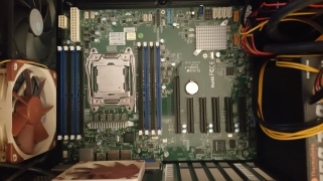Well I have to admit that the AMD experiment was short lived even by ComplaintsHQ standards! To be clear, the FX-8370 is still a great processor and the AM3+ socket is kept pretty modern with 990X chipset. There are some definite pros and cons with this platform. On the plus side:
- Full virtualization feature set – this is a big one for home labs. AMD gives you the full AMD-V set of virtualization extensions across their line including IOMMU (AMD-Vi) for direct mapping of IO to guests in a hypervisor environment.
- Strong single core performance – 4Ghz (4.2Ghz turbo) is a solid clock rate for the money. Yes AMD suffers a pretty bad IPC deficit against Intel these days (probably as bad as 50% against Skylake), but for most commodity workloads where most modern CPUs are generally user input or disk IO constrined, or in a virtualization test bed where host CPU time is efficiently parceled by the hypervisor, or even in high resolution gaming where there is far more burden on the GPU, the Vishera IPC is decent enough that 4Ghz never feels sluggish.
- Bang for the buck – given the above two points, the low price point of the AMD procs starts to look pretty good and this is compounded by the fact that they are still on DDR3 and the motherboards are dirt cheap. This is especially true for a home lab.
Of course it’s not all great:
- RAM limited – this is really a chipset issue, but the 990X boards are going to realistically cap out at 32GB. This makes sense as this is a consumer platform, but it can get tight in home lab scenarios.
- Performance ceiling – As good as the 8370 is, at some point you do hit a wall if the workloads get intense. To be clear, what is meant by intense here is a dozen active VMs, or 1080P game streaming, or heavy real time HD encoding (Plex).
- Architecture limits – this may or may not ever matter. Again, very workload dependent. There is lots of misunderstanding (some deliberate I think) and even more ignorance when it comes to AMDs Clustered Multi-Threading. Let’s keep it simple. The 8 core 8370 has 8 integer cores, but it has 4 L3 caches and 4 Floating Point Units. That’s it. So a pair of integer cores share a cache and an FPU. This will only matter if you have a given workload that is highly CPU cache efficient or is intensely floating point.
So what happened at ComplaintsHQ to send the AMD packing? Nothing dramatic honestly. The FX8370 is a fairly power hungry 125W and was paired with a very power hungry 390x, so this was part of it, but power aside, it was certainly getting the job done just fine in the following use cases:
- NVIDIA GameStream and Steam Streaming – 1080P, max settings, AA off. Managed 30-40fps over 802.11AC in The Evil Within, Crysis 3, Archeage and Bioshock Infinite. This is with the AMD390x
- HyperV Host – running GPU accelerated RemoteFX, VDI and a Windows enterprise mix (AD, SystemCenter, SQL server)
- Encoding – I use a ReadyNAS as a streaming and storage server and love it, but while decently powerful for a NAS, it is too light to use do high bit rate encoding on. Stuff like this I will let run on the server when I need to do it
Here is how the synthetics looked for the FX8370/R9 390x combo in PassMark:

Summarizing the graphs:
- PassMark Rating: 3228
- CPU Mark: 9497
- 2D Graphics Mark: 503
- 3D Graphics Mark: 5989
- Memory Mark: 1264
- Disk Mark: 4222
So what bumped the scrappy, but a bit long in the tooth, AMD out? Well sometimes the market leaders are where they are for a reason:
- CPU – Xeon E5-2630 V4: Yes, this is overkill. 10 cores, 20 threads, 2.2Ghz (3.1Ghz turbo), 85W, Broadwell-EP. What can you say? This thing is a monster. But at $675 it’s as much as the full motherboard/CPU/RAM combo on the AMD side. Is it worth it? Let’s see…
- RAM – Samsung D739E DDR4-2133 16GB ECC Server Memory x 8. At $100 a stick this was an $800 hit, but for a full 128GB of registered ECC DDR4 that’s actually not too bad. Still, “bang for the buck” is now long gone!
- Motherboard – Supermicro X10SRi-F single 2011-V3 socket, Intel C612 Express chipset. The upside to the server boards is they are RAM dense (8 DIMM slots in an ATX package!) and have all sorts of cool features like IPMI, I/OAT and ECC support. The downside is they feature some weirdness like 2011 narrow ILM (more on that later), no onboard audio (no great loss if you’re main out is HDMI) and artifacts of a lost age like jumpers (GASP!). Still a pretty cool piece of kit even if the BIOS does feel ancient.
- GPU – drumroll… Zotac GTX1070. Astute readers will note that the GTX1080 was less than an overwhelming acquisition. The 1070, on the other hand, is a different proposition entirely. At below $500 for the Founders Edition, it delivers near GTX980Ti performance at much lower power draw. It’s very solid in GPGPU as well and makes a fantastic shared GPU for VDI. Leaving the (solidly performing) R9 390x in place was tempting, but the GTX1070 just destroys it (and most everything else) in terms of graphics horsepower:watt. Given that a big part of the motivation for this upgrade was KW/h reduction, it was a perfect fit.
Some parts porn!
So all up this was a $2400 upgrade to a system that was already pushing $2700! This brings the grand total to a whopping $5100. That’s well beyond “on the cheap” and solidly into “batshit crazy for a home lab” territory. To be fair, the AMD CPU, motherboard and GPU sold for a respectable $425 and the RAM should fetch another $50. So pull $475 off the total and we’re at $4625. Still a ton, but this is the final build:
- CPU: Xeon E5 2630 V4, 10 Core
- RAM: 128GB Registered ECC 2133Mhz
- GPU: GTX 1070
- RAID: LSI MegaRaid 9260 8i, 512MB cache, 2 x mini SAS
- LAN: Intel E1G44HTBLK Quad Port server NIC
- HDD: 7 x Seagate ST1000LM014 1TB 2.5″ SATA3 hybrid drive in RAID 6, 1 x Seagate ST1500LM003 1.5TB 2.5″ SATA2 (games), 1 x SanDisk Extreme Pro 240GB SSD SATA3 (boot)
- PSU: Thermaltake ToughPower 750W
- Case: Grandia GD09 HTPC case
The final resource tally is 10 cores, 20 threads (25Ghz), 128GB 2133 RAM, 6.5TB usable bulk storage, 230GB usable SSD, 6 x 1Gb/s Ethernet (6GbE) and hardware RAID 6 with 512MB cache.
But the most important question is how does performance look? Let’s see:

Comparing the two:
| AMD | Intel | Delta | |
| PassMark Rating | 3228 | 4510 | 140% |
| CPU Mark | 9497 | 14024 | 148% |
| 2D Graphics Mark | 503 | 616 | 122% |
| 3D Graphics Mark | 5989 | 10063 | 168% |
| Memory Mark | 1264 | 2330 | 184% |
| Disk Mark | 4222 | 4465 | 106% |
This is a really solid victory for the Intel platform (given the cost differential, it better be!) with an average across tests of a 145% performance gain. Given that the upgrade weighed in at $1900, that’s $42 / percentage point. Personally I feel this is too much to make this upgrade worth it from a pure capital expense standpoint. Of course it also represents the tipping point for certain workloads. As an example, game streaming 1080p, max settings (again no AA to keep the testing consistent) is now a rock solid 60fps. Also, the TDP differences shouldn’t be ignored:
| FX-8370 | E5-2630 | R9-390X | GTX1070 | AMD | Intel | Delta | |
| W Idle | 21 | 15 | 94 | 60 | 115 | 75 | 65% |
| W Load | 81 | 75 | 258 | 161 | 339 | 236 | 70% |
The Intel platform is coming in at only 65% of the power draw of the AMD setup at idle and 70% at peak load (in this case representing Prime95 blend for CPU and Crysis 3 at 4k for GPU)
Converting those numbers to money, if the AMD setup were left idle 24 x 7 x 365 it would cost $146/year at 14.5 cents/KWh to run. The Intel setup would weigh in at $95/year. This $51/year difference is pretty insignificant, but if you run the server at idle full time, it does slowly chip away at the upgrade cost. And of course every time it runs at load, the savings increase since the ratio stays close and the Intel system will stay at peak for a shorter time since it is significantly more performant.
In the end this is a very cool upgrade that can certainly be classified as a pure luxury. A core dense Xeon in a true server board with real server RAM and components in a small form factor at home is something like a Rolex watch. Yes it’s a premium. It is better than lesser components. No you don’t really need it. But you know you want it!




